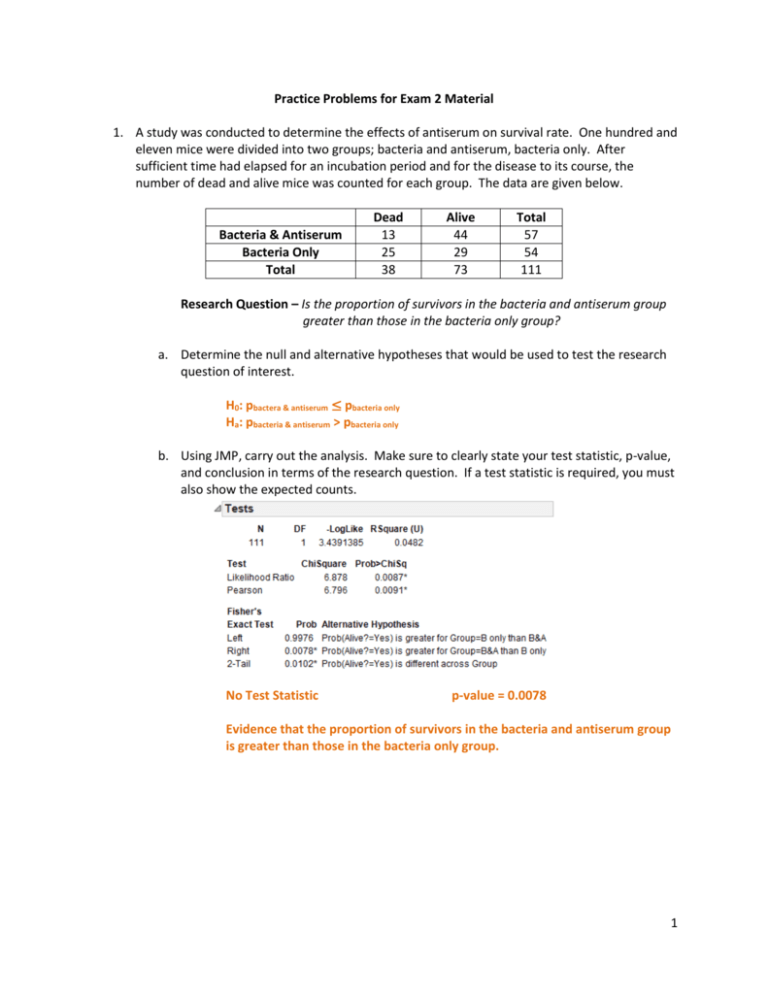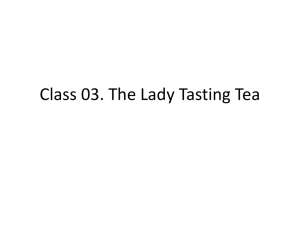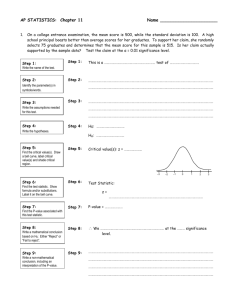Practice Problems for Exam 2 Material A study was conducted to
advertisement

Practice Problems for Exam 2 Material 1. A study was conducted to determine the effects of antiserum on survival rate. One hundred and eleven mice were divided into two groups; bacteria and antiserum, bacteria only. After sufficient time had elapsed for an incubation period and for the disease to its course, the number of dead and alive mice was counted for each group. The data are given below. Bacteria & Antiserum Bacteria Only Total Dead 13 25 38 Alive 44 29 73 Total 57 54 111 Research Question – Is the proportion of survivors in the bacteria and antiserum group greater than those in the bacteria only group? a. Determine the null and alternative hypotheses that would be used to test the research question of interest. H0: pbactera & antiserum ≤ pbacteria only Ha: pbacteria & antiserum > pbacteria only b. Using JMP, carry out the analysis. Make sure to clearly state your test statistic, p-value, and conclusion in terms of the research question. If a test statistic is required, you must also show the expected counts. No Test Statistic p-value = 0.0078 Evidence that the proportion of survivors in the bacteria and antiserum group is greater than those in the bacteria only group. 1 2. During the recent economic recession, many families faced hard times financially. Some studies observed that more people stopped buying name brand products and started buying less expensive store brand products instead. Data produced by a recent sample of 700 adults on whether they usually buy store brand or name brand products are given below. Male Female Total Name Brand 150 160 310 Store Brand 165 225 390 Total 315 385 700 Research Question – Is there evidence of a difference in the proportion of males and females that buy name brand products? a. Set up the null and alternative hypotheses that would be used to test the research question of interest. You may write these in words or symbols. H0: pmales = pfemales Ha: pmales ≠ pfemales b. Using JMP, carry out the analysis. Make sure to clearly state your test statistic, p-value, and conclusion in terms of the research question. If a test statistic is required, you must also show the expected counts. Expected Counts 310 Overall % Name brand = = 0.44 700 390 Overall % Store brand = = 0.56 700 Male Female Total Name Brand 315(0.44) = 138.60 385(0.44) = 169.40 310 Store Brand 315(0.56) = 176.4 385(0.56) = 215.6 390 Total 315 385 700 Since all expected counts ≥ 5, use Chi-square test Test Statistic = 2.579 p-value = 0.1083 There is no statistically significant evidence (since 0.1083 > 0.05) that there is a difference in the proportion of males and females that buy name brand products. 2 3. University of New Mexico professor Jane hood investigated the fieldwork methods used by qualitative sociologists (Teaching Sociology, July 2006). Searching for all published journal articles, dissertations, and conference proceedings over the previous seven years in the Sociological Abstracts database, she discovered fieldwork could be categorized as the following: Interview, Observation + Participation, Observation Only, and Grounded Theory. Furthermore, it has been hypothesized that 70% of fieldwork conducted is done by interview, 15% using Observation + Participation, 10% using Observation Only, and 5% using Grounded Theory. The table below summarizes the number of paper published in the last seven years that fall into each of the above categories. Fieldwork Method Interview Observation + Participation Observation Only Grounded Theory Total Number of Papers 5,079 1,042 848 537 7,506 a. Set up the null and alternative hypotheses that would be used to determine if the observed data are consistent with the hypothesized values. H0: pinterview = 0.70 pobservatio + participation = 0.15 pobservation = 0.10 pgroudned theory = 0.05 Ha: Two or more differ b. Calculate the expected counts that would be used in the computation of the Chi-square test statistic. Interview 7506(0.70) = 5254.2 Observation + Participation 7506(0.15) = 1125.90 Observation 7506(0.10) = 750.6 Grounded Theory 7506(0.05) = 375.3 c. Using JMP, find the Chi-square test statistic and p-value for this study. Test Statistic = 94.4023 p-value = 0.0001 d. Using the p-value from part c, is there evidence that the observed data are consistent with the hypothesized values? Explain. Evidence that the data do not follow the hypothesized breakdown of fieldwork categories. 3 4. Since WSU is a laptop university which gives students the choice of either a MAC or a PC, it may be of interest to determine whether there is a difference in the proportion of males and females who prefer a particular brand. Therefore, a random sample of 208 female students and 122 male students was taken. Of the females selected 134 said they prefer a MAC while 66 of the males selected said they prefer a MAC. a. Construct a 99% confidence interval for the difference in proportions. pˆ male = 66 = 0.54 122 Z = 2.58 (0.64 – 0.54) ± 2.58(0.06) 0.10 ± 0.15 -0.05 ≤ pfemale – pmale ≤ 0.25 134 = 0.64 208 0.54(0.46) 0.64(0.36) = 0.06 + 122 208 pˆ female = (0.54 – 0.64) ± 2.58(0.06) -0.10 ± 0.15 -0.25 ≤ pmale – pfemale ≤ 0.05 OR b. Interpret the 99% confidence interval constructed in part a. 99% confident the true proportion of females who prefer a MAC is between 0.05 smaller and 0.25 larger than the true proportion of males who prefer a MAC. OR 99% confident the true proportion of males who prefer a MAC is between 0.25 smaller and 0.05 larger than the true proportion of females who prefer a MAC. c. Based on the confidence interval constructed in part a, can it be concluded that there is a difference in the proportion of males and females who prefer a MAC laptop? Explain. No, because 0 is included in the confidence interval. 4 5. A study was conducted to investigate gender and the most bothersome symptom for joint disease victims. A random sample of 250 men and 300 women suspected to be joint disease victims was taken. The data are summarized below. Male Female Total Morning Stiffness 111 102 213 Nocturnal Pain 59 73 132 Joint Swelling 80 125 205 Total 250 300 550 Research Question – Is there evidence of a relationship between gender and a person’s most bothersome symptom for joint disease? a. Create a mosaic plot of the data. Looking at the mosaic plot, does there appear to be a relationship between gender and a person’s most bothersome symptom for joint disease? Explain. It appears there might be a relationship between gender and a person’s most bothersome symptom because the patterns differ across gender. b. Determine the appropriate null and alternative hypotheses that would be used to test the research question of interest. H0: Gender and most bothersome symptom are independent (There is no relationship between gender and most bothersome symptom) Ha: Gender and most bothersome symptom are not independent (There is a relationship between gender and most bothersome symptom) 5 c. Using JMP, carry out the remainder of the test. Make sure to clearly check the conditions, indicate the value of the test statistic, p-value, and the conclusion in context of the research question. Expected Counts: 213 % Stiffness = = 0.39 550 132 % Nocturnal = = 0.24 550 205 % Swelling = = 0.37 550 Male Female Total Morning Stiffness 250(0.39) 97.5 300(0.39) 117 213 Nocturnal Pain 250(0.24) 60 300(0.24) 72 132 Joint Swelling 250(0.37) 92.5 300(0.37) 111 205 Total 250 300 550 All ECs ≥ 5 so Chi-square test is appropriate! Test statistic = 7.258 p-value = 0.0265 There is evidence that gender and a person’s most bothersome symptom are not independent. That is, there IS a relationship between gender and a person’s most bothersome symptom. 6 6. A study was done to compare the side effects of taking a new drug. Two hundred individuals were chosen for the study and half were assigned to take the drug and the other half were assigned to take a placebo. Of those given the drug, 10 experienced a headache, while only 5 of those given the placebo experienced a headache. a. Fill in the contingency table below for this scenario. Drug Placebo Total Headache 10 5 15 No Headache 90 95 185 Total 100 100 200 b. Using JMP, find the relative risk of experiencing a headache for those taking the drug compared to those taking the placebo. c. Interpret the relative risk found in part b. The risk/probability of a headache for those taking the drug is 2 times more than the risk/probability of a headache for those taking the placebo. d. Looking at the relative risk found in part b, can you conclude there is a relationship/difference/association in the risk of experiencing a headache for those taking the drug compared to those taking the placebo? Explain. Yes, because the RR ≠ 1 e. Using JMP, find the odds ratio for this scenario. f. Interpret the odds ratio found in part e. The odds of NO headache for those taking the drug is 0.47 times greater than the odds of NO headache for those taking the placebo. 7







